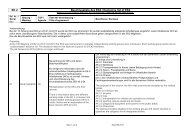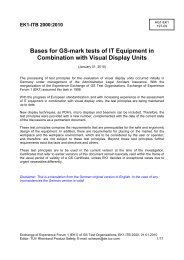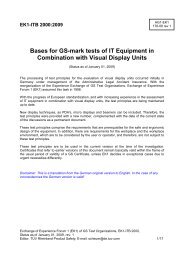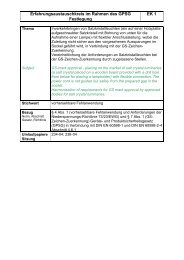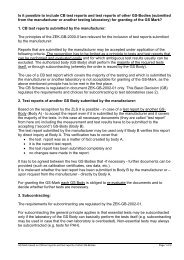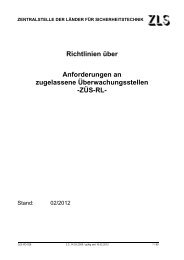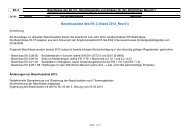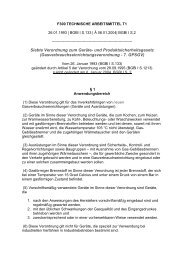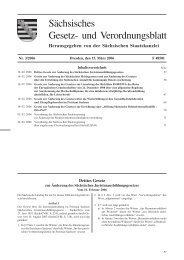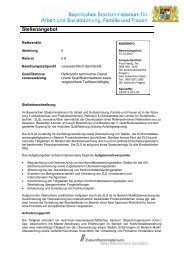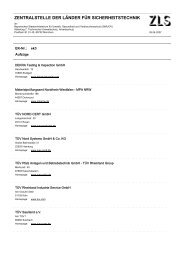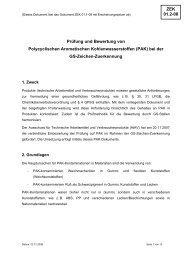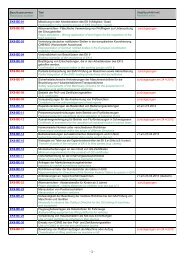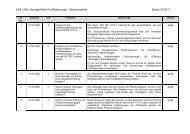EK1-ITB 2000 - ZLS
EK1-ITB 2000 - ZLS
EK1-ITB 2000 - ZLS
- No tags were found...
You also want an ePaper? Increase the reach of your titles
YUMPU automatically turns print PDFs into web optimized ePapers that Google loves.
Annex1 (until release of ISO 9241-3xx)Basis for GS Test of IT Equipment in Combination with Visual Display Units (<strong>EK1</strong>-<strong>ITB</strong> <strong>2000</strong>)(Summary, Date 2008-01-01)AG1-<strong>EK1</strong>160-07RequirementStandard/ ReferenceCRT - VDU Flat panelDisplayPC(System unit)with CRT – VDUor Flat panelDisplayKeyboard Notebook1 Image quality DIN EN 29241-3 X X orDIN EN ISO 13406-2 X X X2 Reflection characteristics DIN EN ISO 9241-7 XDIN EN ISO 13406-2 X X3 Colour requirements DIN EN ISO 9241-8 X X orDIN EN ISO 13406-2 X X X4 Input requirements DIN EN ISO 9241-4 X X 3)DIN 2137 X 2) X 2)5 Sound power level L WAd(Operation accordingto manufacturer)6 Sound pressure level L pAm(Operation accordingto manufacturer)7 Tilt anglemax. forward:min. backward:PrinterScannerPeripheraldevicesNon-keyboardinput devicesDIN EN ISO 9241-9 X XISO 7779 (ISO 9296) X 1) X 1) X X X XBildscharbV, A 17.ISO 7779 (ISO 9296)BildscharbV, A 17.BildscharbV, A 5.X 1) X 1) X X X X5°≥ 5° ≥ 5°≥ 5°8 Swivel (rotation) BildscharbV, A 5. max. ± 180° max. ± 180°9 Max. force to swivel BildscharbV, A 5. max. 100 N max. 100 N10 Brightness adjustable BildscharbV, A 3. X X X11 Contrast adjustable BildscharbV, A 3. X X 4) X 4)12 Gloss of housing BildscharbV, A 8., A 15. ≤ 20 glossunits≤ 20 glossunits≤ 20 gloss units ≤ 20 glossunits≤ 20 glossunits≤ 20 glossunits13 Headphone output EN 50332 X 5) X 5)14 Technical documentation GPSG X X X X X X X X15 User’s manual GPSG X X X X X X X XRemark:4) If technically provided.Requirements marked with X have to be proved.5) if available1) With integrated fan. 6) (Not used)2) With German layout. 7) A mechanism for tilt shall be available, the maximum tilt is 15°.3) Apply DIN EN ISO 9241-4 excluding exeptions given in DIN 2137-12.BildscharbV = German Ordinance for work with Visual Display Units, based on European Council Directive 90/270/EECGPSG = German Product Safety & liability lawExchange of Experience Forum 1 (<strong>EK1</strong>) of GS Test Organizations, <strong>EK1</strong>-<strong>ITB</strong> <strong>2000</strong>, Status as of January 01, 2008Editor: TÜV Rheinland Product Safety; E-mail: scheuer@de.tuv.com 1/19X 7)≤ 20 gloss units
Annex 1 (with release of ISO 9241-3xx)Basis for GS Test of IT Equipment in Combination with Visual Display Units (<strong>EK1</strong>-<strong>ITB</strong> <strong>2000</strong>)RequirementStandard/ ReferenceCRT - VDU Flat panelDisplayPC(System unit)with CRT –VDU or FlatpanelDisplayKeyboard NotebookPrinterScannerPeripheraldevicesNonkeyboardinputdevices1 Image quality DIN EN ISO 9241-3xx X X X X2 Input requirements DIN EN ISO 9241-4 X X 3) X 8)DIN 2137 X 2) X 2)DIN EN ISO 9241-9 X X X 8)3 Sound power level L WAd(Operation accordingto manufacturer)4 Sound pressure level L pAm(Operation accordingto manufacturer)5 Tilt anglemax. forward:min. backward:ISO 7779 (ISO 9296)BildscharbV, A 17.ISO 7779 (ISO 9296)BildscharbV, A 17.BildscharbV, A 5.X 1) X 1) X X X XX 1) X 1) X X X X5°≥ 5° ≥ 5°≥ 5°6 Swivel (rotation) BildscharbV, A 5. max. ± 180° max. ± 180°7 Max. force to swivel BildscharbV, A 5. max. 100 N max. 100 N8 Brightness adjustable BildscharbV, A 3. X X X X 4)9 Contrast adjustable BildscharbV, A 3. X X 4) X 4) X 4)10 Gloss of housing BildscharbV, A 8., A 15.DIN EN ISO 9241-3xxX X ≤ 20 glossunitsX 7)≤ 20 glossunitsX ≤ 20glossunits≤ 20 glossunits≤ 20 glossunits11 Headphone output EN 50332 X 5) X 5) X 5)12 Technical documentation GPSG X X X X X X X X X13 User’s manual GPSG X X X X X X X X X 8)Remark:4) If technically provided.Requirements marked with X have to be proved.5) if available1) With integrated fan. 6) (Not used)2) With German layout. 7) A mechanism for tilt shall be available, the maximum tilt is 15°.3) Apply DIN EN ISO 9241-4 excluding exeptions given in DIN 2137-12. 8) see Annex 5BildscharbV = German Ordinance for work with Visual Display Units, based on European Council Directive 90/270/EEC, GPSG = German Product Safety & liability lawPocket-PC8)XExchange of Experience Forum 1 (<strong>EK1</strong>) of GS Test Organizations, <strong>EK1</strong>-<strong>ITB</strong> <strong>2000</strong>,Status as of January 01, 2008Editor: TÜV Rheinland Product Safety; E-mail: scheuer@de.tuv.com 2/19
Annex 2Test procedure for character heigth: Example for 17“ CRT - VDUViewing distance: 500 mmResolution: 1024 x 768SystemconfigurationFont Character height Matrix Alternative test pattern forcharacter „m“Alternative testpattern forcharacter „e“Small fonts Arial 10 2,95 mm 20,3‘ 7 x 10 !###!###!!###!###!!###!###!!###!###!Large fonts Arial 10 3,7 mm 25,4‘ 9 x 12 !####!####!!####!####!!####!####!!####!####!!!!!########!!!!########!!!!!!!!############!!!!############!!!!Annex 3Cancelled - 12 th meeting AG1 <strong>EK1</strong>Exchange of Experience Forum 1 (<strong>EK1</strong>) of GS Test Organizations, <strong>EK1</strong>-<strong>ITB</strong> <strong>2000</strong>,Status as of January 01, 2008Editor: TÜV Rheinland Product Safety; E-mail: scheuer@de.tuv.com 3/19
Annex 4:Ergonomic Requirements for flat panels for GS-mark(Interpretation of DIN EN ISO 13406-2 according to AG1 of <strong>EK1</strong>, 72a-03 Rev. 1)(Interpretation of DIN EN ISO 9241-3xx)(until release of ISO 9241-3xx)1. Viewing distance (typical)= 500 mm2. Viewing direction class:• Class III: Θ range = Θ range min or according to manufacturers specification• Class II: Θ range = 2 x arc tan Dactive/Ddesign view but < 80°• Class I: Θ range ≥ 80 °3. Equation 49 in chapter 8.7.2.1 does not apply for viewing direction class I.4. Required inclination-angle range classes shall be taken from table 45.5. Set up of the display:a) Use of the natural resolutionb) Verical frequency = 60 Hz or according to manufacturers specificationc) Adjust brightness to maximumd) Adjustment of the screen at analogues input: use auto adjustment (if an auto adjustmentis not available use a pixel checkerboard for adjustment (clock, pase and geometry))e) Generate a gray scale image: gray steps of more than 10% must be visuallydistinguishablef) Warm-up time before test: minimum 1 h, better 2 h (use a screen saver during warm-up)g) Colour temperature: according to manufacturers specification otherwise 6500 K.Exchange of Experience Forum 1 (<strong>EK1</strong>) of GS Test Organizations, <strong>EK1</strong>-<strong>ITB</strong> <strong>2000</strong>,Status as of January 01, 2008Editor: TÜV Rheinland Product Safety; E-mail: scheuer@de.tuv.com 4/19
6. Guideline for the GS testRequirement Classes obligatory for GS mark7.1 Design viewing≥400mm500 mmdistance(touch screens)≥300 mm7.2 Design viewing I,II,III,IV Table 45direction7.3 Design screenilluminationemissive displays 250-750 lx Screen tilt angle 10°250 lx + 250 lx cos αtransflective andMinimum illuminance Minimum illuminancereflective displaysDefined by the Defined by the manufacturermanufacturer7.5 Chromaticity I,II,III,IV IV Table 45uniformity difference7.6 Character height ≥16 ´ 20´ - only for fix fonts7.7 Stroke width 8% till 20% 8% till 20% - only for fix fonts7.8 Character width to0,5:1 till 1:1 0,5:1 till 1:1 - only for fix fontsheight ratio7.9 Fill factor ≥0,3 ≥0,37.10 Character format ≥ 5x7 ≥ 7x9 - only for fix fonts7.11 Betweencharacter≥ 1 pixel≥ 1 pixel - only for fix fontsspacing7.12 Between- word≥ 1 pixel≥ 1 pixel - only for fix fontsspacing7.13 Between-line≥ 1 pixel≥ 1 pixel - only for fix fontsspacing7.14 Display I,II,III,IV III Table 45luminance7.15 Contrast I,II,III,IV III Table 457.17 Reflectionsclass reflection I,II,III I,II or III see <strong>EK1</strong>-<strong>ITB</strong> <strong>2000</strong> and <strong>EK1</strong>decision A.2.9.57.17.1 Contrast in the I,II,III,IV I,II,III,IV see <strong>EK1</strong>-<strong>ITB</strong> <strong>2000</strong> and <strong>EK1</strong>presence ofdecision A.2.9.5reflections7.17.2 Contrast of un- I,II,III,IV I,II,III,IV see <strong>EK1</strong>-<strong>ITB</strong> <strong>2000</strong> and <strong>EK1</strong>wanted reflections7.18 Image polarity If the screen isintended for use innegative and positivepolarity, use bothpolarities during thetests.decision A.2.9.5If the screen is intended for use innegative and positive polarity, useboth polarities during the tests.Exchange of Experience Forum 1 (<strong>EK1</strong>) of GS Test Organizations, <strong>EK1</strong>-<strong>ITB</strong> <strong>2000</strong>,Status as of January 01, 2008Editor: TÜV Rheinland Product Safety; E-mail: scheuer@de.tuv.com 5/19
Requirement Classes obligatory for GS mark7.19 Luminance I,II,III,IV IV Table 45uniformity7.20 Pixel faults I,II,III,IV I,II,III,IV I or II according to Table 37.21 Image formationtimemanufacturers specification withintable 1t≤10 ms10
with release of ISO 9241-3xxDetermination of the intended context of use according to ISO 9241-307, (example)Element Attribut QuantificationUser Vision User with normal or to normal corrected vision of any age, 7 years or older(any literate user).EnvironmentTaskDesign screen illuminance, E STypical components of theillumination: Large aperture source(15°) and small aperture source(1°) illuminationIlluminantAmbient temperatureContent and perceptionAmount of informationImage typeDesign viewing distance, D design,viewDesign viewing direction, Θ D, Φ DDesign viewing direction range(angle of inclination and azimuth)Eye and head positionNumber of usersVertical 250 lx + 250 lx × cos(α) in offices, where α is the screen tilt angle.The screen tilt angle is considered to be 75°.1. L REF,EXT= 200 cd/m 2 and L REF,SML= 2 000 cd/m 2 (suitable forgeneral office use);2. L REF,EXT= 200 cd/m 2 or L REF,SML= 2 000 cd/m 2 (suitable for most,but not all, office environments);3. L REF,EXT= 125 cd/m 2 or L REF,SML= 200 cd/m 2 (requires a speciallycontrolled luminous environment).Dabei ist:L REF,EXTis the luminance of the large aperture source (15°) andL REF,SMLis the luminance of the small aperture source (1°).CIE illuminant D65ambient temperature of approximate 15°C to 35°C is considered.Artificial informationPreferred screen size for sufficient amount of information with appropriateobject size and resolution.Still image, quasi-static or moving image is considered, if not otherwisespecified by the supplier.500 mmWithin a specific range of angles from the normal.Viewing cone with a single visual displayThe maximum inclination angle range Θ rangeis:Θ range= 2 × arctan(D active/2 × D design,view). WhereD activeis the diagonal of the active display area andD design,viewis the design viewing distance.The design inclination angle is within 0° ≤ Θ D≤ 40° – Θ range/2. The azimuthangle Φ is 0° bis 360°.NOTE This definition correspond to viewing direction range classClass viewing III of earlier ISO 13406-2.From fixed to moving.Typical single or multiple.Usage Display handling For this compliance route stationary display handling is considered, if nototherwise specified by the supplier.Exchange of Experience Forum 1 (<strong>EK1</strong>) of GS Test Organizations, <strong>EK1</strong>-<strong>ITB</strong> <strong>2000</strong>,Status as of January 01, 2008Editor: TÜV Rheinland Product Safety; E-mail: scheuer@de.tuv.com 7/19
Annex 5:Ergonomic Requirements for Pocket-PC‘s (AG1 of <strong>EK1</strong>, 70-02)1. Definition: Pocket-PCPC with integrated Display, which is smaller than DIN A4 (12 th meeting AG1 <strong>EK1</strong>) and whichincludes an alphanumeric keyboard and/or a pen for data input and which is not used forsteady work of visual display tasks.2. Use of Pocket-PCIn general Pocket-PC’s are hold by hand or standy-situated on a table.3. Requirements according <strong>EK1</strong>-<strong>ITB</strong> <strong>2000</strong> and remarksuntil release of ISO 9241-3xx the following table is validdon’t use the following table with release of ISO 9241-3xxRequirements Standards /references Pocket-PC1 Image Quality ISO 13406-2 see a)2 reflection characteristics ISO 13406-2 see a)3 Color characteristics ISO 13406-2 see a)4 Input requirements DIN EN ISO 9241-4DIN 2137see b)5 Sound power level LWAd(operation accordingmanufacturer)6 Schalldruckpegel LpA(Betrieb laut Hersteller)7 tilt anglemax. forward:min. backward:DIN EN ISO 9241-9ISO 7779 (ISO 9296)BildscharbV, A 17.ISO 7779 (ISO 9296)BildscharbV, A 17.BildscharbV, A 5.see c)N/A8 Swivel rotation BildscharbV, A 5. N/A9 force to swivel BildscharbV, A 5. N/A10 brightness adjustable BildscharbV, A 3. X (as far as foreseen)11 contrast adjustable BildscharbV, A 3. X (as far as foreseen)12 gloss of housing (reflections) BildscharbV, A 8.,A 15.13 technical documentation GSG X14 User’s manual GSG X see d)With X marked requirements basically have to be fulfilled.N/AN/A≤ 20 Gloss unitsExchange of Experience Forum 1 (<strong>EK1</strong>) of GS Test Organizations, <strong>EK1</strong>-<strong>ITB</strong> <strong>2000</strong>,Status as of January 01, 2008Editor: TÜV Rheinland Product Safety; E-mail: scheuer@de.tuv.com 8/19
until release of ISO 9241-3xx the following table 3 a) is validdon’t use the following table 3 a) with release of ISO 9241-3xxa) Display and information presentation (ISO 13406-2):Clause DIN EN Applicability/LimitationISO 13406-27.1 Design viewing distanceViewing distance min. 300mm at pocket PC’s held by handViewing distance min. 500mm at pocket PC’s lying on table7.2 Design viewing directionTaking into account a viewing direction of up to 20° (max. 40°).7.3 Design screen illuminanceSpecification of minimum and maximum ambient illumination bymanufacturer7.4 Gaze and head-tilt anglesN/A7.5 Chromaticity uniformity differenceminimum Viewing direction class IV7.6 Character heightCharacter height minimum 20-22 minutes of arc7.7 Stroke widthApply7.8 Character width-to-height ratioApply7.9 Fill factorApply7.10 Character formatApply7.11 Between-character spacingApply7.12 Between-word spacingApply7.13 Between-line spacingApply7.14 Display luminanceIllumination according actual presented research resultsWith integrated illumination: minimum 3cd/m² .7.15 ContrastContrast according actual presented research results−0,65−0,65CRmin= 2,2 • (1+2,2 • LL) = 2,2 + 4,84 • LL7.16 Luminance balanceN/A7.17 ReflectionsSmall sized specular reflections (1°) are not to be considered as they canbe eliminated by typical use. Only diffuse and specular big sizedreflections (15°) have to be considered.7.18 Image polarityApply7.19 Luminance uniformityMinimum Viewing direction class IV7.20 Pixel faultsApplyExchange of Experience Forum 1 (<strong>EK1</strong>) of GS Test Organizations, <strong>EK1</strong>-<strong>ITB</strong> <strong>2000</strong>,Status as of January 01, 2008Editor: TÜV Rheinland Product Safety; E-mail: scheuer@de.tuv.com 9/19
7.21 Image formation timeApply7.22 Absolute luminance codingN/A7.23 Blink codingN/A7.24 Temporal instability (flicker)Apply: Flickermeasurement can also be performed for grey-scale7.25 Default colour setApply7.26 Multicolour object sizeN/A7.27 Colour differencesAnwenden7.28 Spectrally extreme coloursN/A7.29 Number of coloursN/Ab) Keyboard of Pocket-PC‘s (ISO 9241-4, ISO/IEC 9995):Clause Applicability/LimitationISO 9241-46.1.1 Palm-restsN/A6.1.2 Sections of the keyboardN/A6.1.3 Home row heightN/A6.1.4 Slope of the keyboardApply6.1.5 Profile of keyboardAnwenden6.1.6 Keyboard surfaces and material properties of keyboardsApply6.1.7 Keyboard placementN/A6.1.8 Keyboard slope adjustment mechanismN/A6.2.1 Key layout and center-line spacingN/A6.2.2 Keytop designMinimum 64mm²6.2.3 Key displacement and forceAnwenden6.2.4.1 GeneralApply6.2.4.2 Kinaesthetic feedbackN/AExchange of Experience Forum 1 (<strong>EK1</strong>) of GS Test Organizations, <strong>EK1</strong>-<strong>ITB</strong> <strong>2000</strong>,Status as of January 01, 2008Editor: TÜV Rheinland Product Safety; E-mail: scheuer@de.tuv.com 10/19
6.2.4.3 Auditory feedbackN/A6.2.4.4 Visual feedbackApply6.2.5 Rebound action (bounce)Apply6.2.6 Key roll-overApply6.2.7 Key repeat functionApply (Software)6.2.8.1 Graphical symbolsN/A6.2.8.2 Geometric design of key legendsApply6.2.8.3 Number and positioning of legendsN/A6.2.8.4 Durability of legendsApply6.2.9 Cursor keys and keys in the editing sectionApply modified6.2.10 Numeric keypadApply if applicable6.2.11 Keytop shapeApplyExchange of Experience Forum 1 (<strong>EK1</strong>) of GS Test Organizations, <strong>EK1</strong>-<strong>ITB</strong> <strong>2000</strong>,Status as of January 01, 2008Editor: TÜV Rheinland Product Safety; E-mail: scheuer@de.tuv.com 11/19
ISO/IEC 9995Clause Applicability/LimitationISO 9995-17.4 Key location numbering requirementsAnwendbar8.1 Group positionsErsten Absatz nicht anwendenZweiten Absatz anwenden8.2 Level positions within one groupAnwendbar, wenn die drei Ebenen in einer Spalte dargestellt werdenClause Applicability/LimitationISO 9995-27 Arrangement and location of keys in the alphanumeric zone of thealphanumeric sectionN/A8 Functions of the alphanumeric zone of the alphanumeric sectionApplicableClause Applicability/LimitationISO 9995-35 Common secondary group layoutApplicable6 Complementary Latin group layoutApplicableClause Applicability/LimitationISO 9995-45-10 Apply if presentClause Applicability/LimitationISO 9995-55-12 Apply grouping of Cursor keys only as „Cross“ or „Inverte T“ LayoutApplicability/LimitationClauseISO 9995-65-6 ApplyClause Applicability/LimitationISO 9995-75 Descriptions of functionsNot to apply as used keys are not commonly usedClause Applicability/LimitationISO 9995-85-6 Apply if presentc) Pen (ISO 9241-9):Requiremnets according ISO 9241-9:<strong>2000</strong> Clause 6.2.6.1 (Grasp surface), 6.2.6.5 (Size)und 6.2.6.6 (Weight) shall be fulfilled.d) Remark in the Users Manual and certificate„not for permanent video display work“„nicht für stänige Bildschirmarbeit geeignet“Exchange of Experience Forum 1 (<strong>EK1</strong>) of GS Test Organizations, <strong>EK1</strong>-<strong>ITB</strong> <strong>2000</strong>,Status as of January 01, 2008Editor: TÜV Rheinland Product Safety; E-mail: scheuer@de.tuv.com 12/19
Annex 6: Data to be provided by the GS certificate (minimum)a) Notebookuntil release of ISO 9241-3xx the following table is validItem Example Item1 Zertifikat-Nr.Certificate No.123456789 2 AusstellungsdatumDate of Issue3 Genehmigungsinhaber Notebook GmbH4 FertigungsstätteLicense Holder5 Abbildung des PrüfzeichensFigure of test mark7 PrüfgrundlagenTest basis8 Zertifiziertes Produkt(Geräteidentifikation)Certified Product(Product identification)9 Nennspannung/-frequenzRated VoltageRated Frequency10 NennstromRated Current11 SchutzklasseProtection Class12 LCD-Display/ModulLCD Panel13 PixelfehlerklassePixel Fault Class14 Reflexionsklasse(für pos./neg. Polarität)Reflection Class(neg./pos. Polarity)15 Blickrichtungsklasse für denKontrastClass Viewing Contrast16 Blickrichtungsklasse für dieFarbenClass Viewing Colour17 SchalldruckpegelSound Pressure level18 deklarierterSchallleistungspegelDeclared Sound Power Level19 Gültigkeitsdauer desZertifikatesCertificate valid until20 Name des ZertifizierersName of the person who doesthe certification22 Zertifizierungsstelle mitAngabe der AnschriftManufacturing Plant= GS-Zeichen der Prüfstelle 6 PrüfberichtsnummerTest Report No.EN 60950-1:2001<strong>EK1</strong>-<strong>ITB</strong> <strong>2000</strong>:2004BezeichnungType designationXvc V/u HzS ANXyxxxx123Pc/defg/hUi dBKl dB(A)uv.wx.yzV. Certus 21 Unterschrift des ZertifizierersSignature of the person whodoes the certificationCert GmbH, CerthausenCertification Body inc. address23 Hinweis, dass dem Zertifikat eine Prüf- und Zertifizierungsordnung zugrunde liegt.Hint, that the certificate is based on Testing and Certification Regulations.24 Feststellung, dass das Produkt die Anforderungen des GPSG erfüllt.Statement, that the product meets the requirements of GPSG.Exchange of Experience Forum 1 (<strong>EK1</strong>) of GS Test Organizations, <strong>EK1</strong>-<strong>ITB</strong> <strong>2000</strong>,Status as of January 01, 2008Editor: TÜV Rheinland Product Safety; E-mail: scheuer@de.tuv.com 13/19
a) Notebookwith release of ISO 9241-3xx use the following tableBezeichnung Beispiel Bezeichnung1 Zertifikat-Nr.Certificate No.123456789 2 AusstellungsdatumDate of Issue3 Genehmigungsinhaber Notebook GmbH4 FertigungsstätteLicense Holder5 Abbildung des PrüfzeichensFigure of test mark7 PrüfgrundlagenTest basis8 Zertifiziertes Produkt(Geräteidentifikation)Certified Product(Product identification)9 Nennspannung/-frequenzRated VoltageRated Frequency10 NennstromRated Current11 SchutzklasseProtection Class12 LCD-Display/ModulLCD Panel13 PixelfehlerklassePixel Fault Class14 Geeignet für Umgebungennach EN 12464-1Suitable for environmentsaccording to EN 12464-115 vorgesehener Sehabstanddesign viewing distance16 vorgesehene Sehrichtungund Sehrichtungsbereichdesign viewing direction andviewing direction rangeInhalt und WahrnehmungContent and perception17 SchalldruckpegelSound Pressure level18 deklarierterSchallleistungspegelDeclared Sound Power Level19 Gültigkeitsdauer desZertifikatesCertificate valid until20 Name des ZertifizierersName of the person who doesthe certification22 Zertifizierungsstelle mitAngabe der AnschriftCertification Body inc. addressManufacturing Plant= GS-Zeichen der Prüfstelle 6 PrüfberichtsnummerTest Report No.EN 60950-1:2005<strong>EK1</strong>-<strong>ITB</strong> <strong>2000</strong>:2007BezeichnungType designationXvc V/u HzS ANXyxxxx123Pef°Ui dBKl dB(A)uv.wx.yzV. Certus 21 Unterschrift des ZertifizierersSignature of the person whodoes the certificationCert GmbH, Certhausen23 Hinweis, dass dem Zertifikat eine Prüf- und Zertifizierungsordnung zugrunde liegt.Hint, that the certificate is based on Testing and Certification Regulations.24 Feststellung, dass das Produkt die Anforderungen des GPSG erfüllt.Statement, that the product meets the requirements of GPSG.Exchange of Experience Forum 1 (<strong>EK1</strong>) of GS Test Organizations, <strong>EK1</strong>-<strong>ITB</strong> <strong>2000</strong>,Status as of January 01, 2008Editor: TÜV Rheinland Product Safety; E-mail: scheuer@de.tuv.com 14/19
) Flat Panel Displayuntil release of ISO 9241-3xx the following table is validItem Example Item1 Zertifikat-Nr.Certificate No.123456789 2 AusstellungsdatumDate of Issue3 Genehmigungsinhaber Display GmbH4 FertigungsstätteLicense Holder5 Abbildung des PrüfzeichensFigure of test markManufacturing Plant= GS-Zeichen der Prüfstelle 6 PrüfberichtsnummerTest Report No.7 PrüfgrundlagenTest basis8 Zertifiziertes Produkt(Geräteidentifikation)Certified Product(Product identification)9 Nennspannung/-frequenzRated VoltageRated Frequency10 NennstromRated Current11 SchutzklasseProtection Class12 LCD-Display/ModulLCD Panel13 PixelfehlerklassePixel Fault Class14 Reflexionsklasse(für pos./neg. Polarität)Reflection Class(neg./pos. Polarity)15 Blickrichtungsklasse für denKontrastClass Viewing Contrast16 Blickrichtungsklasse für dieFarbenClass Viewing ColourEN 60950-1:2001<strong>EK1</strong>-<strong>ITB</strong> <strong>2000</strong>:2004BezeichnungType designationXvc V/u HzS ANXyxxxx123Pc/defg/h19 Gültigkeitsdauer desZertifikatesCertificate valid until20 Name des ZertifizierersName of the person who doesthe certification22 Zertifizierungsstelle mitAngabe der AnschriftCertification Body inc. addressuv.wx.yzV. Certus 21 Unterschrift des ZertifizierersSignature of the person whodoes the certificationCert GmbH, Certhausen23 Hinweis, dass dem Zertifikat eine Prüf- und Zertifizierungsordnung zugrunde liegt.Hint, that the certificate is based on Testing and Certification Regulations.24 Feststellung, dass das Produkt die Anforderungen des GPSG erfüllt.Statement, that the product meets the requirements of GPSG.Exchange of Experience Forum 1 (<strong>EK1</strong>) of GS Test Organizations, <strong>EK1</strong>-<strong>ITB</strong> <strong>2000</strong>,Status as of January 01, 2008Editor: TÜV Rheinland Product Safety; E-mail: scheuer@de.tuv.com 15/19
) Flat Panel Displaywith release of ISO 9241-3xx use the following tableBezeichnung Beispiel Bezeichnung1 Zertifikat-Nr.Certificate No.123456789 2 AusstellungsdatumDate of Issue3 Genehmigungsinhaber Display GmbH4 FertigungsstätteLicense Holder5 Abbildung des PrüfzeichensFigure of test markManufacturing Plant= GS-Zeichen der Prüfstelle 6 PrüfberichtsnummerTest Report No.7 PrüfgrundlagenTest basis8 Zertifiziertes Produkt(Geräteidentifikation)Certified Product(Product identification)9 Nennspannung/-frequenzRated VoltageRated Frequency10 NennstromRated Current11 SchutzklasseProtection Class12 LCD-Display/ModulLCD Panel13 PixelfehlerklassePixel Fault Class14 Geeignet für Umgebungennach EN 12464-1Suitable for environmentsaccording to EN 12464-115 vorgesehener Sehabstanddesign viewing distance16 vorgesehene Sehrichtungund Sehrichtungsbereichdesign viewing direction andviewing direction rangeInhalt und WahrnehmungContent and perceptionEN 60950-1:2005<strong>EK1</strong>-<strong>ITB</strong> <strong>2000</strong>:2007BezeichnungType designationXvc V/u HzS ANXyxxxx123Pcd/m² / cd/m²ef°19 Gültigkeitsdauer desZertifikatesCertificate valid until20 Name des ZertifizierersName of the person who doesthe certification22 Zertifizierungsstelle mitAngabe der AnschriftCertification Body inc. addressuv.wx.yzV. Certus 21 Unterschrift des ZertifizierersSignature of the person whodoes the certificationCert GmbH, Certhausen23 Hinweis, dass dem Zertifikat eine Prüf- und Zertifizierungsordnung zugrunde liegt.Hint, that the certificate is based on Testing and Certification Regulations.24 Feststellung, dass das Produkt die Anforderungen des GPSG erfüllt.Statement, that the product meets the requirements of GPSG.Exchange of Experience Forum 1 (<strong>EK1</strong>) of GS Test Organizations, <strong>EK1</strong>-<strong>ITB</strong> <strong>2000</strong>,Status as of January 01, 2008Editor: TÜV Rheinland Product Safety; E-mail: scheuer@de.tuv.com 16/19
c) PC (Personal Computer)Item Example Item1 Zertifikat-Nr.Certificate No.123456789 2 AusstellungsdatumDate of Issue3 GenehmigungsinhaberLicense HolderPC GmbH4 FertigungsstätteManufacturing Plant5 Abbildung des PrüfzeichensFigure of test mark= GS-Zeichen der Prüfstelle 6 PrüfberichtsnummerTest Report No.7 PrüfgrundlagenTest basis8 Zertifiziertes Produkt(Geräteidentifikation)Certified Product(Product identification)9 Nennspannung/-frequenzRated VoltageRated Frequency10 NennstromRated Current11 SchutzklasseProtection ClassEN 60950-1:2001<strong>EK1</strong>-<strong>ITB</strong> <strong>2000</strong>:2004BezeichnungType designationXvc V/u HzS AN17 SchalldruckpegelUi dBSound Pressure level18 deklarierterKl dB(A)SchallleistungspegelDeclared Sound Power Level19 Gültigkeitsdauer des uv.wx.yzZertifikatesCertificate valid until20 Name des ZertifizierersName of the person who doesthe certificationV. Certus 21 Unterschrift des ZertifizierersSignature of the person whodoes the certification22 Zertifizierungsstelle mit Cert GmbH, CerthausenAngabe der AnschriftCertification Body inc. address23 Hinweis, dass dem Zertifikat eine Prüf- und Zertifizierungsordnung zugrunde liegt.Hint, that the certificate is based on Testing and Certification Regulations.24 Feststellung, dass das Produkt die Anforderungen des GPSG erfüllt.Statement, that the product meets the requirements of GPSG.Exchange of Experience Forum 1 (<strong>EK1</strong>) of GS Test Organizations, <strong>EK1</strong>-<strong>ITB</strong> <strong>2000</strong>,Status as of January 01, 2008Editor: TÜV Rheinland Product Safety; E-mail: scheuer@de.tuv.com 17/19
Annex 7 Requirements for Electronic Scales7.1 DefinitionElectronic scales with indicators for the weighing of wares for use at cash registers andweihing work stations.Note: Products limited to a single indicator line are exempt.7.2 ApplicationElectronic scales are used at display terminal work stations (i.e. as weighing or measuringinstruments by employees of markets).The use/implementation usually takes place at stationary cash register and weighing workstations as well as at standing and sitting work stations.7.3 RequirementsElectronic scales with LCD indicators and display terminals must comply with the samerequirements as those for flat panel displays. The actual context of use (environment, task,user) are to be taken into consideration. For technologies other than LCD, the analogequivalent standardized requirements apply.until release of ISO 9241-3xx the following table is validRequirement Standard / Referenz Elektronic Scale1 Image quality DIN EN 29241-3DIN EN ISO 13406-2 X 1)2 Reflection characteristics DIN EN ISO 9241-7DIN EN ISO 13406-2 X 1)3 Colour requirements DIN EN ISO 9241-8DIN EN ISO 13406-2 X 1)4 Input requirements DIN EN ISO 9241-4 –DIN 2137 –5 Sound power level L WAd(Operation accordingto manufacturer)6 Sound pressure level L pAm(Operation accordingto manufacturer)7 Tilt anglemax. forward:min. backward:DIN EN ISO 9241-9ISO 7779 (ISO 9296)BildscharbV, A 17.ISO 7779 (ISO 9296)BildscharbV, A 17.BildscharbV, A 5.Exchange of Experience Forum 1 (<strong>EK1</strong>) of GS Test Organizations, <strong>EK1</strong>-<strong>ITB</strong> <strong>2000</strong>,Status as of January 01, 2008Editor: TÜV Rheinland Product Safety; E-mail: scheuer@de.tuv.com 18/19X––≥ 5°8 Swivel (rotation) BildscharbV, A 5. –9 Max. force to swivel BildscharbV, A 5. –10 Brightness adjustable BildscharbV, A 3. X11 Contrast adjustable BildscharbV, A 3. X 2)12 Gloss of housingBildscharbV, A 8., A 15. ≤ 20 gloss units(Reflexion)13 Headphone output EN 50332 –14 Technical documentation GPSG X15 Instructions for use GPSG XRemarks:Requirements marked with an X must always be included1) Also included is an analysis of the character attributes of the variouscharacter sets as well as the contrast and reflection of the various colorcombinations.2) if technically provided
with release of ISO 9241-3xx use the following tableRequirement Standard / Referenz Elektronic Scale1 Image quality DIN EN ISO 9241-3xx X 1)2 Input requirements DIN EN ISO 9241-4 –DIN 2137 –3 Sound power level L WAd(Operation accordingto manufacturer)4 Sound pressure level L pAm(Operation accordingto manufacturer)5 Tilt anglemax. forward:min. backward:DIN EN ISO 9241-9ISO 7779 (ISO 9296)BildscharbV, A 17.ISO 7779 (ISO 9296)BildscharbV, A 17.BildscharbV, A 5.X––≥ 5°6 Swivel (rotation) BildscharbV, A 5. –7 Max. force to swivel BildscharbV, A 5. –8 Brightness adjustable BildscharbV, A 3. X9 Contrast adjustable BildscharbV, A 3. X 2)10 Gloss of housingBildscharbV, A 8., A 15.X(Reflexion)DIN EN ISO 9241-3xx11 Headphone output EN 50332 2)12 Technical documentation GPSG X13 Instructions for use GPSG XRemarks:Requirements marked with an X must always be included1) Also included is an analysis of the character attributes of the variouscharacter sets as well as the contrast and reflection of the various colorcombinations.2) if technically providedExchange of Experience Forum 1 (<strong>EK1</strong>) of GS Test Organizations, <strong>EK1</strong>-<strong>ITB</strong> <strong>2000</strong>,Status as of January 01, 2008Editor: TÜV Rheinland Product Safety; E-mail: scheuer@de.tuv.com 19/19



